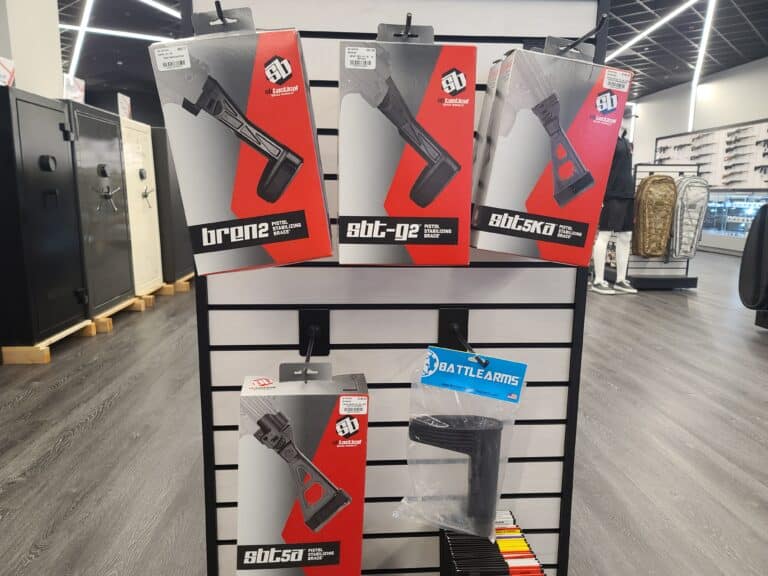The ATF broke the law when crafting its rule requiring the destruction or registration of guns with pistol braces.
That’s the ruling a Fifth Circuit Court of Appeals panel handed down on Tuesday. In a two-to-one ruling, the panel found the ATF exceeded its authority in trying to reclassify braced guns and subject them to greater regulation under federal law. It determined the agency had illegally crossed the line from enforcing to legislating, and the resulting rule “must be set aside as unlawful or otherwise remanded for appropriate remediation.”
“The Final Rule affects individual rights, speaks with the force of law, and significantly implicates private interests,” Judge Jerry E. Smith wrote for the majority in Mock v. Garland. “Thus, it is legislative in character.”
The decision throws more water on the president’s unilateral attempts to expand gun restrictions through actions by executive agencies. It follows the Fifth Circuit tossing out Biden’s attempt to ban the sale of unserialized parts for homemade firearms and the holdover bump stock ban from the Trump Administration, which the Biden Administration had defended in court.
The case centered around the ATF’s attempt earlier this year to classify nearly all guns with a barrel shorter than 16 inches long and a pistol brace attached to them as short-barrel rifles (SBRs). That was the culmination of the agency’s decade-long flip-flopping on what laws braced guns fall under, with it usually coming down on the side of them being pistols instead of rifles. The change in interpretation meant braced guns would be subject to the National Firearms Act (NFA) of 1934, which regulates SBRs alongside machineguns and silencers.
To comply with the NFA, anyone who owned one of the millions upon millions of braced guns estimated to have been sold under the agency’s previous guidance would have to register them with the ATF or face potential federal felony charges. However, as the Fifth Circuit Panel noted in its ruling by citing The Reload’s exclusive reporting, the ATF saw little compliance with the registration requirement even after waiving the $200 tax traditionally required during the NFA registration process.
“The final rule provided possessors of such firearms the option to comply with the registration requirements of the National Firearms Act through a tax-free process using either the ATF eForms System or a paper application process with a deadline for such applications of 11:59 PM (ET) on May 31, 2023,” Erik Longnecker, Deputy Chief of the ATF’s Public Affairs Division, told The Reload in June. “As of June 1, 2023, ATF received 255,162 applications for tax-free registration.”
Longnecker noted owners could also comply with the rule by dismantling, destroying, or turning in their firearms. But he said the ATF had no estimate for how many people may have taken those routes.
“ATF is unable to estimate the number of possessors of such firearms that used either of these methods to comply with the final rule,” he said. “Likewise, we have no data currently available for the number of firearms abandoned to ATF.”
Regardless, given the low compliance rate, the rule likely implicates millions of Americans. That’s one of the significant reasons the Fifth Panel concluded it was more akin to lawmaking than law enforcement in its ruling.
The panel found the plaintiffs were likely to succeed in their claims that the ATF’s pistol-brace rule violates the Administrative Procedures Act (APA). It kept in place the multiple injunctions that barred the ATF from enforcing the rule against members of the Second Amendment Foundation, Firearms Policy Coalition (FPC), Gun Owners of America, or customers of Maxim Defense. But it sent the case back down to a district judge to rule on the scope of the required injunction.
The gun-rights activists behind the case celebrated the decision as a win for gun owners.
“Said in its simplest terms, the Fifth Circuit just indicated that the Plaintiffs–Firearms Policy Coalition, Maxim Defense, and FPC’s individual members–are likely to defeat ATF’s pistol brace rule when the merits of this case are finally heard,” Cody J. Wisniewski, FPC’s counsel in the case, said in a statement. “This is a huge win for peaceable gun owners across the nation, a huge win for FPC’s members, and yet another massive defeat for ATF and this administration’s gun control agenda.”
The Department of Justice did not respond to a request for comment.
Much of the Fifth Circuit panel’s issue with the rule stems from how the ATF went about implementing it. While the agency offered a proposed rule and took public comments as required under the APA, the panel accused the ATF of ignoring the overwhelmingly negative response and adopting a final rule entirely different from the proposed one without warning. It found that when the agency wholesale removed a point system for determining whether a braced gun was an SBR or a pistol, the result was to create an entirely new rule.
“[N]owhere in the Proposed Rule did the ATF give notice that it was considering getting rid of the Worksheet for a vaguer test,” Judge Smith, a Reagan appointee, wrote for the majority. “Instead, the ‘Comments Sought’ section of the Proposed Rule requested only ‘additional criteria that should be considered’ and comments on whether the ATF ‘selected the most appropriate criteria.’ Proposed Rule at 30850. Removing all objective criteria operates a rug-pull on the public.”
It said the agency should have started over on the months-long rulemaking process if it thought the proposal was untenable after receiving feedback. Instead, the court accused the ATF of adopting a rule that is impossible for the people it casts legal jeopardy over to understand.
“Under the Final Rule, it is nigh impossible for a regular citizen to determine what constitutes a braced pistol, and outside of the sixty contemporaneous adjudications that the ATF released, whether a specified braced pistol requires NFA registration,” Judge Smith wrote. “In particular, the requirements involving analysis of third parties’ actions, such as the ‘manufacturer’s direct and indirect marketing and promotional materials,’ and ‘[i]nformation demonstrating the likely use of the weapon in the general community,’ Final Rule at 6480, would hold citizens criminally liable for the actions of others, who are likely unknown, unaffiliated, and uncontrollable by the person being regulated.”
The panel further castigated the ATF for arguing that its rule does not necessarily reclassify all braced guns. They noted the agency didn’t provide a single example of a braced gun that wouldn’t be an SBR under the rule.
“The ATF theorized that under this new definition of ‘rifle,’ approximately 99% of pistols with stabilizing braces would be classified as rifles; it issued approximately 60 contemporaneous adjudications with the Rule classifying various configurations of firearms with stabilizing braces as rifles,” the court wrote. “No explanations are included for how the ATF came to its conclusion as to each weapon and platform. The AR-type firearm with an SB-Mini accessory, determined to be a braced pistol under the Proposed Rule, now appears to be adjudicated as an SBR under the Final Rule. We also cannot find a single given example of a pistol with a stabilizing brace that would constitute an NFA-exempt braced pistol.”
Judge Smith said the agency’s argument that it was not creating new restrictions had “extraordinary implications.”
“Inspecting the Final Rule from 10,000 feet, it has significant implications for braced-pistol owners,” he wrote. “If the government is correct, and the rule is only interpretive, millions of Americans were committing a felony the entire time they owned a braced pistol.”
He also argued the logic implied the change in the agency’s posture on braced guns did constitute a legislative effect.
“Before the Final Rule, the ATF would not prosecute an individual for owning a braced pistol,” Judge Smith wrote. “There was no indication that persons or organizations acted unlawfully before the Final Rule’s publication by possessing or transferring a braced pistol. Post-Final Rule, the government has attempted to claim that the stabilizing braces were always unlawful—but that is flatly unpersuasive given the history of ATF regulation and action. The character of the rule is legislative.”
Judge Stephen A. Higginson, an Obama appointee, dissented. He argued the ATF was within its power to issue the rule and that it went through the process correctly. He also argued that braced guns are dangerous and unusual.
“I disagree that these braces are, in relevant regard, ‘safety-improving modifications,'” he wrote. “Increased concealability and accuracy, at least in the hands of killers, is not ‘safe’—it is lethal.”
The panel returned the case to the judge who initially denied a preliminary injunction against the rule. They asked him to conduct fact-finding and build a record on the merits. They noted it was too early for them to issue an injunction, especially a nationwide one, as the plaintiffs had requested.
But they also noted that nationwide injunctions are sometimes merited, mainly if the plaintiffs in the case are scattered across the country.
“Still, in certain circumstances, nationwide relief is appropriate and may be necessary for the benefit of all parties,” Judge Smith wrote. “In Feds for Medical Freedom, for example, the en banc court permitted a nationwide injunction because the organization’s membership numbered thousands, and the members were scattered nationwide. In those circumstances, we reasoned that ‘limiting the relief to only those before [the court] would prove unwieldy and would only cause more confusion.’ Moreover, injunctions should be crafted to ‘provide complete relief to the plaintiffs.'”
The Fifth Circuit panel gave the district judge 60 days to issue a ruling on the scope of the injunction.







Only Members can view comments. Become a member today to join the conversation.